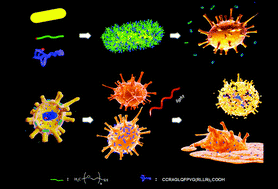Integration of antimicrobial peptides and gold nanorods for bimodal antibacterial applications†
Abstract
The misuse and abuse of antibiotics have given rise to a severe problem of the drug resistance of bacteria. Solving this problem has been a vitally important task in the modern medical arena. In this work, an antimicrobial peptide (AMP), BF2b, and gold nanorods (AuNRs) were used to develop a specific drug delivery system for killing methicillin-resistant Staphylococcus aureus (MRSA). On the one hand, BF2b has unique anti-bacterial performance and has a lower tendency than traditional antibiotics to engender the drug resistance of bacteria. On the other hand, AuNRs have diverse distinct properties, such as photo-thermal conversion, which can be employed for photo-thermal sterilization. We aimed to integrate the anti-bacterial activity of BF2b and the photo-thermal sterilization of AuNRs to kill drug-resistant bacteria. Fourier-transform infrared spectroscopy, microBCA and zeta potential measurements were utilized to characterize the product, AuNR@PEG/BF2b. Transmittance electron microscopy, UV-vis spectroscopy and photothermal conversion measurement were conducted to verify the stability and photothermal conversion capacity of AuNR@PEG/BF2b. Cell viability and hemolysis assay were carried out to test the biocompatibility of AuNR@PEG/BF2b. Finally, the in vitro and in vivo experiments were performed to demonstrate the excellent bactericidal activity of AuNR@PEG/BF2b.



 Please wait while we load your content...
Please wait while we load your content...